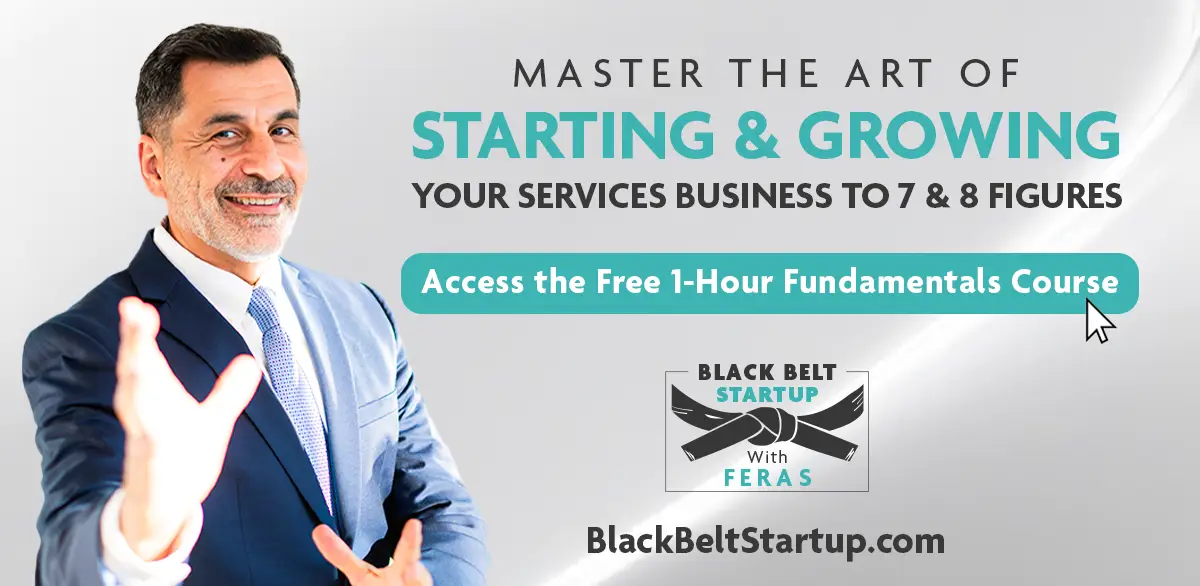How to Close Deals Faster: 7 Effective Sales Strategies for Any Service Startup

“Speed is the ultimate weapon in the quest for success.”
– Sir Richard Branson
The faster you turn leads into customers, the faster you get paid. Closing deals fast improves cash flow and confidence and adds to your feeling of competence in your work. Speed is your most powerful tool.
So how do you close a deal faster?
In this article, I will share 7 strategies to help you do just that. By shortening your sales cycle – the time that elapses from a lead’s first inquiry until the moment you close the deal – you can spend more time and energy on prospects who want to do business with you. But before I do that, let me explain a few essential ideas that you need to know. The first and most important is having a good understanding of the sales process.
Watch the video where I cover this topic in depth:
Understanding the Sales Process
Seventy-nine percent of leads are never converted. A lot of businesses overlook designing a process that nurtures leads into paying clients. I can’t emphasize enough how important it is for new business owners to adopt a sales system, track leads, and provide the right sales support throughout the process.
A big part of your sales cycle includes creating a sales funnel, which is a process that charts the journey leads take from their first interaction with you until they turn into paid clients. Cultivating the relationship with your leads through each stage is referred to as lead nurturing.
Although the journey is complex and rarely linear, approaching it as a funnel helps you address the typical questions and fears a lead may have at each stage. Your job throughout is to educate – to provide value and help them solve pain points.
Here is a quick overview of the key stages of a funnel that I cover extensively in the Ultimate Guide to Mastering a Sales Funnel for Service Businesses:
- Awareness: people know you exist and you have a service to offer
- Education: you’re getting to understand the prospect’s pain points and they’re getting more acquainted with you
- Evaluation: you’re providing additional education and also defending against other providers the lead is potentially speaking with
- Negotiation: the lead is ready to sign, but they want you to sweeten the deal
- Sale: you’ve converted a lead to a paid client. Congrats!
How many steps in a sales funnel?
Why are there so many different sales and marketing funnels, some with four stages, others with six, eight, or even ten? Some are more nuanced for clarification, and others are for more complex processes. There’s no hard and fast answer. My advice is to focus on the concepts behind the stages and avoid putting too much focus on the specific number of stages.
And finally, it’s a good idea to make the whole process as seamless and automated as possible without defaulting to a one-size-fits-all approach. Avoid sending every client identical emails, quotes, or proposals. Use systems and checklists to make the process easier to manage, but also tailor solutions to meet the specific needs and challenges of each prospective client, as outlined in the strategies we discuss below.
Before we move on to the seven, let’s also cover the most common issues that come up in the sales cycle.
What are the common challenges and obstacles to closing deals faster?
Many factors, including those below, can cause delays or derail the deal altogether:
- Insufficient knowledge of your lead’s industry
- Inadequate understanding of competing providers your lead may also be considering
- Inability to get through gatekeepers to the people in the organization who wield the power to sign a contract
- Delivering your sales pitch before establishing a level of rapport and trust
- Inability to negotiate working terms and address objections
Many of these bottlenecks and obstacles can be remedied by monitoring how well the lead understands and connects to your value proposition and how it differs from the competition. In my experience, most challenges are symptomatic of the client not seeing the unique value you offer.
Now that we’ve covered the sales process and the common obstacles, here are the 7 strategies you can implement to help you get to a closed deal faster.
1- Streamline Your Sales Process to Close More Deals
- Preparation: outline the sales process as a checklist you can repurpose for each new deal; this way, no steps are missed.
- Expertise: continue to build your expertise and mastery of your technical domain, and always be on the lookout about new challenges in the industry. The more you know about these challenges, the better equipped you are to address your leads’ questions with potential solutions in a timely manner.
- Trust building: establish rapport and showcase past successes to foster trust. At the end of the day, people buy from people, when leads experience your responsiveness and professionalism, you start gaining their trust, and subsequently reduce their skepticism and moves the deal closer to the finish line.
- Key decision maker engagement: develop techniques to connect with decision makers swiftly, whether through direct contact or indirect strategies.
- Effective communication: use active listening, note-taking, and follow-up to ensure clear understanding and alignment throughout the sales process.
- Negotiation skills: employ empathy and flexibility in negotiations, offering tailored solutions and incentives to close deals efficiently.
- Detailed proposals: Provide comprehensive proposals addressing all client needs and outlining clear solutions, pricing, and terms.
- Create urgency: use authentic urgency tactics, such as limited availability, to prompt timely decision-making. This is a common tactic used by many salespeople.
2- Leveraging Technology in Sales Acceleration
The harder it is to do something, the less likely we are to do it. That’s just a fact of being human, no matter how disciplined you think you are.
Read any decent book on forming good habits and you’ll find them talking about associating the new habit with an ingrained habit, keeping resources for the habit nearby, and setting the achievement bar low.
Your prospects are no different.
The more steps you insert into the sales process, the less likely they are to follow through, or at least, follow through quickly.
Think about your proposal process. Do you have an online proposal that’s as easy to access as a web page with in-proposal links to help them take the next step? Or do they have to download a compressed file, unzip it, and install a reading app on their computer?
What about your contracts? If you require them to print, sign, and scan (or… gulp … even fax) the documents, you’re adding friction.
Each step needed to close the deal adds friction. Each step is a potential deal-failure point. To make the deal close more smoothly, it’s time to introduce modern sales tools and software. Every quarter it seems, there are new automation and optimization opportunities made available for business owners.
Examples of technology-driven solutions that can reduce the friction:
- Using e-signature services like DocuSign or xodo sign.
- Use online hosted proposals, or make your proposal an online presentation.
- Accept various forms of payment, including check, credit card, PayPal, Swipe, Zelle, and ACH, to make payment super-easy.
Don’t go cheap when selecting services that can remove sales friction. View anything that helps you close and collect payment faster as an investment, not an expense.
3- Prioritize Progress Tracking and Performance Analysis
Reflect on previous deals you’ve closed. While it’s not unusual to do a project post-mortem, looking at what went well and what needed improvement within a project, I find few entrepreneurs who reflect deeply on lost (and even won) deals.
We learn from our failures more than we learn from our successes. Here’s where the importance of metrics and analytics comes in – keeping track not just of your won vs. lost deals, but also tracking ways to improve the sales process.
Consider your past 5 – 10 deals, both those you won and those you lost:
- What did you spend too much time on?
- What did you have to create or spend time on that could be turned into a template or checklist so it goes quicker next time?
- How fast and often did you follow up?
- How clear were the communications?
Even finding just one thing that you can improve can help you close the next deal faster.
Tools For Tracking Sales Performance
To help with tracking and sales metrics, you should use a CRM like Salesforce, HubSpot, Streak, or any other tool that fits your needs. Each worthwhile CRM offers reports and processes to manage and track your sales performance.
If you’re starting out, a simple spreadsheet with detailed notes on every interaction with the lead and the next steps would suffice. But as you get more leads, you’ll eventually need to invest in a more comprehensive tool.
4- Continuous Improvement and Adaptation
Apply these process improvement steps to help accelerate sales.
The Importance of Following Up (The 2-1-2 Benchmark System)
I never cease to be amazed by how many founders I meet who do not follow up with prospective clients.
According to Invesp, 44% of salespeople give up after one touch-base, and 80% of closed deals require 5 follow-ups.
But more important than just following up, you must also do so quickly.
For instance, I’m currently working with an award-winning industry leader. Despite his accolades and being well-liked within his field, he is very bad at getting back to people quickly. He often follows up with a lead months after the initial contact with no communication in between.
Don’t communicate like him.
Not following up on your networking and sales efforts is like herding cattle into a corral and then leaving the gate open. It’s a waste of time. You’d be just as well not doing any work.
Create a follow-up system and stick to it. For instance, you can borrow my 2-1-2 system below or whatever strategies for ongoing improvement work best for you and your situation.
1. Respond to communications within TWO business hours
New leads may submit a contact us or newsletter form on your website. Sales prospects might send emails or leave voicemails or text messages. Whatever form the communication is in, decide how quickly you will respond. I aim for up to 2 hours, but you can use whatever number makes sense to you.
2. Take the FIRST appointment a lead offers
As long as you don’t have to cancel appointments with other prospects or important clients, do whatever it takes to make that first slot offered work. Move things around on your calendar, call in favors, stay up extra late, or get up extra early.
3. Send materials within TWO business days after a pitch or presentation
If the pitch went reasonably well, you will follow up with a proposal and, depending on the size of the project or client, an additional, more formal presentation. Commit to sending that proposal along with a schedule request for the presentation if applicable, within 2 business days or sooner after the first pitch.
5- Ask for Legal and Insurance Paperwork Earlier in the Process
If you are in the B2B space, especially if you’re targeting mid-to-large-size companies, legal reviews in the sales process are pretty typical. There’s nothing worse than having everything lined up to close the deal and start delivering the service and the prospect saying, “So all we need you to do is review our standard agreements….”
The process of reviewing NDAs, MSAs, intellectual property agreements, and other legal documentation can be like molasses in the gears of closing the deal.
Request a contract review as early as possible within the sales process. The timing of this request can be tricky. I advise you to make this request in the 80-95% certainty of a close range.
The request can be as simple as saying, “It seems like we’re on the verge of moving forward. To save time, I think we could exchange any disclosures and boilerplate contracts for a preliminary legal review.” More often than not, the prospect will appreciate the foresight and will be happy to comply. If not, you have lost nothing by making the request.
In addition to legal contracts and disclosures, many companies have other requirements for vendors, such as bonding or insurance certifications. Ask for the procurement department to provide this information around the same time as the legal information. It’s a good idea to tackle these other requirements early, so you’re ready to move forward when the business decision-maker gives the go-ahead.
6- Leverage Your Time Through a Team
In an upcoming article, I will share an approach for making your first sales hire. While that can certainly improve your efficiency, you do not need a sales team, or even one sales professional, to increase the speed of your sales process.
First, let’s do a bit of math. Calculate your net revenue for each deal closed and your hourly rate based on the time invested in the process and delivering to the client. Can you hire someone for one-quarter to one-third of that hourly rate to handle administrative duties?
Once you create assets and streamline and document your entire process, you are in a better situation to hire someone to take over these processes. This hire doesn’t have to be sales-specific. Even a virtual assistant can save you time and help with:
- Contract creation and management
- Follow-up emails (using your templates)
- Coordinating schedules
- Putting together proposal
- Creating more systems for your onboarding process: checklists, FAQs, video training, etc.
The sooner you can hand off some routine processes, the sooner you will have the focus to bring in more clients faster.
7- Close More Deals by Having Better Qualified Leads
You don’t just want any leads. If you take time to answer emails and calls from every Tom, Diane, and Sally, you’re going to have less time to spend with the leads you want to do business with.
Let’s say you have 20 leads contact you. Out of those 20, you close 2 deals. You have a 10% conversion rate, right?
What if you spent time only on the 10 of those leads who could afford your price and had an immediate need? Then your conversion rate is 20%. But you wasted time sifting through the 20 to find the 10.
So, how do you separate the serious leads from the rest? By attracting, connecting with, and bringing in qualified leads. It starts at the very top of your marketing and sales funnels.
Let’s assume your goal is $200,000 in revenue. By better qualifying leads in advance, you increase your conversion rates, and, instead of talking to 200 leads to get 20 sales at $10,000 per project, you only need to focus on 100.
You just cut your effort nearly in half.
The more qualified the lead is at the top of your sales funnel, the more likely they are to make a buying decision.
How to Qualify Your Lead
Begin by making sure the audience you’re targeting has the budget and an urgent need for your services. One way to do this is to ask pre-qualifying questions in your online materials, such as contact forms or email sign-up lists, or via online meeting scheduling software. All allow you to install question-and-answer fields to get a better sense of the prospect’s quality.
But if your first real interaction is on the phone or in person, you can also start by laying the groundwork with similar questions.
Here are a few examples of questions you can ask, whether they call your office, or message you through LinkedIn:
- Can you summarize your current business or project?
- Have you hired a service provider like us before, and what were your expectations of them?
- What is your expected timeline for this project?
- How will you measure the success of this project – what specific outcomes or improvements are you hoping to achieve?
- What is your annual revenue?
- What specific challenges or goals are you looking to address with our service?
- Do you have a budget for this project/service?
- How many employees do you have?
- Who are the key decision-makers involved in this process, and how soon will they get involved?
Key decision makers
This last point is particularly critical. Do your best to determine and speak with the real decision maker(s) in the process, regardless of their titles, as early as possible.
In addition, the information on your website and online business profiles can include words and images that strongly hint at the types of clients who are a good match:
- Size of companies you’ve worked with, including prominent logos
- Verbiage (and, as applicable, photos or videos) specific to the vertical/client niche you work with
- Outline of a typical working engagement with you, including payment terms and typical project time length
- The starting price of your packages. (Further thoughts on this below.)
While these questions are aimed at B2B leads, they can be tailored to suit a B2C prospect just as well.
Pricing on your website
In regard to the last bullet above, there are debates about placing pricing on websites, since there is some risk in scaring away potential leads.
If the price point for your services is on the higher side, you might consider omitting any direct mentions on your website and discussing or presenting pricing only after you’ve been able to communicate the unique value that your service provides.
Evaluate which approach might be best for you.
Key Takeaways and Action Items for Closing Sales Deals Faster
Early-stage business founders ask, “How do I close deals?” Later-stage founders ask, “How can I close deals faster?” Speed matters for your cash flow and for helping you focus time and energy on growing the business.
When you shorten the sales cycle and boost your conversion rates, your ability to hit your goals expands exponentially.
To win deals faster:
- Streamline deal closing processes:
- Be prepared – create checklists and templates and know your subject and your prospect’s most likely needs in advance
- Maintain expertise – stay on top of industry developments and new challenges that potential clients may be facing
- Build trust – establish rapport and gain your leads’ trust to reduce skepticism and shorten the sales cycle
- Connect with the key decision makers: get all involved in the decision-making as soon as possible… foster a relationship
- Avoid misunderstandings – communicate effectively through active listening and email summaries of meetings and agreements
- Master negotiation skills
- Provide detailed quotes to avoid ambiguity
- Create a sense of urgency
- Leverage technology to reduce friction
- Using e-signature services like DocuSign or xodo sign.
- Use online hosted proposals, or make your proposal an online presentation
- Accept various forms of payment, including check, credit card, PayPal, Swipe, Zelle, ACH to make payment super-easy.
- Prioritize progress tracking
- You can’t improve what you don’t measure. Establish a process to capture and track key information about the deals you’re losing (and those you’re winning), and incorporate your learning into future client interactions.
- Implement the 2-1-2 Benchmark System for effective and speedy follow-ups.
- Respond to communications within two business hours.
- Take the first appointment offered.
- Send materials within three business days.
- Request legal documentation and insurance requirements early: Ask for legal reviews and any insurance requirements in the late stages of the sales process to avoid delays.
- Leverage Your Time Through a Team: perform a cost-benefit analysis to see if it makes sense for you to bring on others to help close with tasks like:
- Contract creation and management
- Follow-up emails (using your templates)
- Coordinating schedules
- Putting together proposals
- Creating more systems for your onboarding process
- Engage with better qualified leads
- Double your conversions by eliminating low- and unqualified leads early
- Qualify your lead through automated and in-person questions
- Talk to the decision maker as early in the process as possibly
Action Items
- Streamline: create templates for common tasks, including proposals, emails, and contracts.
- Reduce sales friction: look for ways to minimize or eliminate steps for your prospects.
- Perform a cost-benefit analysis for bringing on additional help.
- Review past deals: find 3 things you can improve immediately.
- Implement the 2-1-2 benchmark system: document your commitment to respond to leads in a timely manner and stick to it.
- Introduce pre-qualifying filters: create a questionnaire, quiz, or checklist for leads to self-qualify. Then create a list of probing questions to ask in the initial contact.




